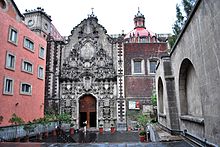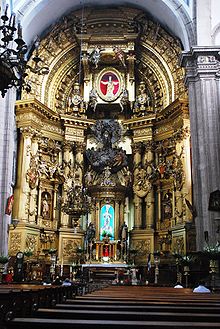- Church of San Francisco, Madero Street, Mexico City
-
The Church of San Francisco is located at the western end of Madero Street in the historic center of Mexico City, near the Torre Latinoamericana and is all that remains of the church and monastery complex. This complex was the headquarters of the first twelve Franciscan monks headed by Martín de Valencia who came to Mexico after receiving the first authorization from the Pope to evangelize in New Spain.[1] In the early colonial period, this was one of the largest and most influential monasteries in Mexico City. It was built on the site of where Moctezuma II’s zoo once was. At its peak, the church and monastery covered the blocks now bordered by Bolivar, Madero, Eje Central and Venustiano Carranza Streets,[2] for a total area of 32,224 square meters.[1]
In the patio of the first cloister, there was a cross that was reputedly taller than the highest tower in the city and made from a cypress tree from the “Chapultepec Forest”, meaning the forested area to the west of the Zocalo, where San Francisco was built.[1]
The church and monastery saw a number of historic events in its time. A funeral mass for Hernán Cortés was here when it was thought that he died in Central America. In 1629, the Marquis of Gelves arrived in disguise to hide after quarreling with the archbishop. In 1692, the Count of Galve and his wife were granted refuge there due to a large-scale rebellion in the city. The end of the Mexican War of Independence was celebrated with a Te Deum at the monastery as the Trigarante Army of 16,000 troops marched past on Madero Street headed by Agustín de Iturbide.[1] After the Reform War, the monastery of San Francisco, like many others, was disbanded and most of the property seized by the government. Much of the old monastery was demolished for the construction of new roads. Other parts of the old building are now a Methodist church facing Gante Street and a Panadería Ideal bakery.[2] Where the bakery is now on 16 de Septiembre Street used to be the De Profundus Room, and the church is housed in the old cloister. On the corner of Venustiano Carranza and Eje Central are what used to be the Calvario and San Antonio chapels. These buildings still exist only because it was more expensive to demolish them than to leave them standing. All that is still left in church hands is the church itself.[2][1]
The church standing today is the third to be built on the site. The first two sunk into the soft soil underneath Mexico City and had to be torn down. [2] This church was built between 1710 and 1716. Although the entire building is known as the San Francisco Church, the entrance on Madero Street is actually the entrance to the Balvanera Chapel. In front of this is an atrium with several sets of stairs leading down to the church building because it, too, is sinking. The church’s main facade, dating from 1710, is walled in and cannot be seen.[2] Entrance is now through the side door into the Balvanera Chapel, then into the main church. [2] The facade of the chapel was constructed in 1766 and it is not sure who constructed it but most think it was the work of Lorenzo Rodríguez, best known for his work on the Metropolitan Tabernacle. The chapel’s statues were removed when the chapel was in the hands of an Evangelical sect, but it kept other decorative elements such as volutes, sculpted leaves and flowers and the estipite (inverted truncated pyramid) columns with medallions. Inside there is an 18th century altarpiece dedicated to the Virgin of Guadalupe as well as the entrance to what was once the Chapel of the Second Station of the Stations of the Cross.[1]
In the main church, there is a large gilded main altar, which is one that replaced the original Baroque one. This original one has been reconstructed because Neoclassic artist Jerónimo Antonio Gil left a drawing of it. Only the walls of the original De Profundis Room remain, the rest is remodeled into a bakery. The old cloister on Gante Street has fared a bit better. It is now a Methodist church, where inside both floors of the cloister have been well-preserved. It can be visited only with prior authorization.[1]
References
Landmarks and historic buildings of Mexico City Centro Zócalo
and immediate vicinitySchools and colleges Universidad del Claustro de Sor Juana · Academia Mexicana de la Historia · Academy of San Carlos · Colegio de San Ignacio de Loyola Vizcaínas · Antigua Escuela de Economía · Colegio Nacional · Colegio de Minería
Government buildings Old Customs Building · Chamber of Deputies · Departamento de Estadistica Nacional · Secretariat of Public Education Main Headquarters · Senate building · Supreme Court building · Palace of the Marqués del Apartado · Library of the Congress of Mexico
Religious buildings Nuestra Señora de Loreto Church · Church of San Francisco · Church of Nuestra Señora de Valvanera · Church of San Bernardo · Ex Temple of Corpus Christi · La Enseñanza Church · La Merced Cloister · La Santisima Church · Temple and Ex-convent of Jesus Maria · Church of San Juan de Dios · Santa VeraCruz Church · Regina Coeli Church · Santa Teresa la Antigua · Temple of San Pablo el Nuevo · Church of Santo Domingo · Temple of Saint Augustine · Temple of San Felipe Neri "La Profesa" · Church of La Soledad
Museums San Ildefonso College · Caricature Museum · Franz Mayer Museum · Museum of the City of Mexico · Interactive Museum of Economics · Museo de Arte Popular · José Luis Cuevas Museum · Palace of the Inquisition (Museum of Mexican Medicine) · Mexican Army Museum · Museo Nacional de Arte · Museo de Charrería · Museo de la Estampa · Museo de Estanquillo · Museum Archive of Photography · Museum of Secretaría de Hacienda y Crédito Público · San Pedro y San Pablo College (Museum of Light) · House of the First Print Shop in the Americas · National Museum of Cultures · Borda House, Mexico City
Palaces Castillo de Chapultepec · Palace of Iturbide · Palacio de Bellas Artes · Palacio de Correos de Mexico · Casa de los Azulejos · Houses of the Mayorazgo de Guerrero · Palace of the Marqués del Apartado · Palacio de la Autónomia
Historic houses Tlaxcala House · House of Count de la Torre de Cossio · House of the Marquis of Uluapa · House of the Count de la Torre Cosío y la Cortina
Other Plaza Garibaldi · Antigua Escuela de Jurisprudencia · Chinatown (Barrio Chino) · Tlaxcala House · Garden of the Triple Alliance · Centro Cultural de España (Mexico City) · INAH Building · Abelardo L. Rodriguez Market · La Merced Market · Lirico Theatre · Alameda Park · Plaza Santo Domingo · Teatro Hidalgo · Teatro de la Ciudad · Torre Latinoamericana · Hospital de Jesús Nazareno · Tlaxcoaque
Coordinates: 19°26′0.42″N 99°8′24.71″W / 19.43345°N 99.1401972°W
Categories:- Buildings and structures in Mexico City
- Landmarks in Mexico City
- Roman Catholic churches in Mexico
- Churches in Mexico City
- 19th century in Mexico
- Colonial Mexico
- Spanish Colonial architecture in Mexico
- Mexican architecture
- Neoclassical architecture in Mexico
- Baroque architecture
Wikimedia Foundation. 2010.


